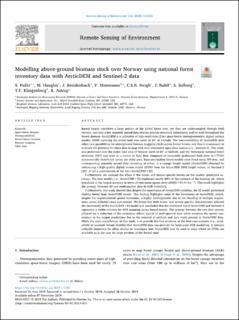| dc.description.abstract | Boreal forests constitute a large portion of the global forest area, yet they are undersampled through field surveys, and only a few remotely sensed data sources provide structural information wall-to-wall throughout the boreal domain. ArcticDEM is a collection of high-resolution (2 m) space-borne stereogrammetric digital surface models (DSM) covering the entire land area north of 60° of latitude. The free-availability of ArcticDEM data offers new possibilities for aboveground biomass mapping (AGB) across boreal forests, and thus it is necessary to evaluate the potential for these data to map AGB over alternative open-data sources (i.e., Sentinel-2). This study was performed over the entire land area of Norway north of 60° of latitude, and the Norwegian national forest inventory (NFI) was used as a source of field data composed of accurately geolocated field plots (n=7710) systematically distributed across the study area. Separate random forest models were fitted using NFI data, and corresponding remotely sensed data consisting of either: i) a canopy height model (ArcticCHM) obtained by subtracting a high-quality digital terrain model (DTM) from the ArcticDEM DSM height values, ii) Sentinel-2 (S2), or iii) a combination of the two (ArcticCHM+S2). Furthermore, we assessed the effect of the forest- and terrain-specific factors on the models’ predictive accuracy. The best model (,i.e., ArcticCHM+S2) explained nearly 60% of the variance of the training set, which translated in the largest accuracy in terms of root mean square error (RMSE=41.4 t ha−1 ). This result highlights the synergy between 3D and multispectral data in AGB modelling. Furthermore, this study showed that despite the importance of ArcticCHM variables, the S2 model performed slightly better than ArcticCHM model. This finding highlights some of the limitations of ArcticDEM, which, despite the unprecedented spatial resolution, is highly heterogeneous due to the blending of multiple acquisitions across different years and seasons. We found that both forest- and terrain-specific characteristics affected the uncertainty of the ArcticCHM+S2 model and concluded that the combined use of ArcticCHM and Sentinel-2 represents a viable solution for AGB mapping across boreal forests. The synergy between the two data sources allowed for a reduction of the saturation effects typical of multispectral data while ensuring the spatial consistency in the output predictions due to the removal of artifacts and data voids present in ArcticCHM data. While the main contribution of this study is to provide the first evidence of the best-case-scenario (i.e., availability of accurate terrain models) that ArcticDEM data can provide for large-scale AGB modelling, it remains critically important for other studies to investigate how ArcticDEM may be used in areas where no DTMs are available as is the case for large portions of the boreal zone. | en_US |

